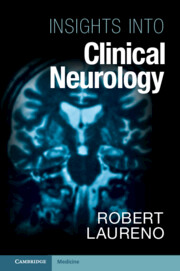Book contents
- Insights into Clinical Neurology
- Insights into Clinical Neurology
- Copyright page
- Dedication
- Contents
- Preface
- Acknowledgments
- Chapter 1 The Amnesic Syndrome
- Chapter 2 Aphasia, Apraxia, and Agnosia
- Chapter 3 Spurious Symptoms and Behaviors
- Chapter 4 Hallucinations
- Chapter 5 Grasping and the Grasp Reflex
- Chapter 6 Asterixis
- Chapter 7 Discussion of the Upper Motor Neuron Syndrome
- Chapter 8 Some Aspects of the Lower Motor Neuron Syndrome
- Chapter 9 The Limbic System
- Chapter 10 Vibration Sensation, the Posterior Columns, and Related Topics
- Chapter 11 Transneuronal Effects
- Chapter 12 Spinal Nerve Roots
- Chapter 13 Ischemic Hypoxic Encephalopathy
- Chapter 14 The Liver–Brain Relationship in Wilson Disease
- Chapter 15 Wernicke Disease
- Chapter 16 Delayed Neurologic Disorders after Toxic or Metabolic Insults
- Chapter 17 Transolfactory Spread in the Pathogenesis of Meningoencephalitis
- Chapter 18 Neurologic Disorders in Endocarditis
- Chapter 19 Secondary Abscess Formation in Primary Brain Lesions
- Chapter 20 Progressive Multifocal Leukoencephalopathy: The Early Years
- Index
- References
Chapter 3 - Spurious Symptoms and Behaviors
Published online by Cambridge University Press: 27 July 2023
- Insights into Clinical Neurology
- Insights into Clinical Neurology
- Copyright page
- Dedication
- Contents
- Preface
- Acknowledgments
- Chapter 1 The Amnesic Syndrome
- Chapter 2 Aphasia, Apraxia, and Agnosia
- Chapter 3 Spurious Symptoms and Behaviors
- Chapter 4 Hallucinations
- Chapter 5 Grasping and the Grasp Reflex
- Chapter 6 Asterixis
- Chapter 7 Discussion of the Upper Motor Neuron Syndrome
- Chapter 8 Some Aspects of the Lower Motor Neuron Syndrome
- Chapter 9 The Limbic System
- Chapter 10 Vibration Sensation, the Posterior Columns, and Related Topics
- Chapter 11 Transneuronal Effects
- Chapter 12 Spinal Nerve Roots
- Chapter 13 Ischemic Hypoxic Encephalopathy
- Chapter 14 The Liver–Brain Relationship in Wilson Disease
- Chapter 15 Wernicke Disease
- Chapter 16 Delayed Neurologic Disorders after Toxic or Metabolic Insults
- Chapter 17 Transolfactory Spread in the Pathogenesis of Meningoencephalitis
- Chapter 18 Neurologic Disorders in Endocarditis
- Chapter 19 Secondary Abscess Formation in Primary Brain Lesions
- Chapter 20 Progressive Multifocal Leukoencephalopathy: The Early Years
- Index
- References
Summary
Quasi-neurological problems can be spurious, the product of the mind or emotions. Distinguishing such conditions from coarse brain disease is accomplished by systematic neurologic analysis. Many of these patients are depressed or malingering. Intense emotions may account for other cases. In a given patient more than one of these terms may be applicable.
- Type
- Chapter
- Information
- Insights into Clinical Neurology , pp. 14 - 24Publisher: Cambridge University PressPrint publication year: 2023



